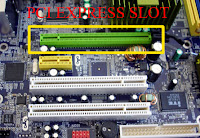Pci Express Slot evolution of the PCI expansion bus
PCI Express Slot
is the evolution of the PCI expansion bus, first introduced with the Pentium,
which has replaced the old interface for graphics cards, the AGP.
It is based on a serial data transfer, unlike the parallel PCI, which simplifies the layout of the motherboard PCB and consists of a series of channels. This allows a considerable modularity, as more channels can be aggregated to increase the bandwidth available or to support specific configurations such as the use of two or more video cards. In addition, the bandwidth of each channel is independent from that of others.
PCI Express 1.0
PCI Express was designed to support the growing energy needs of the latest generation of video cards. Unlike the AGP slot, capable of delivering a maximum of 50 watts, the current revision of PCI-Ex supports loads up to 75W, making it possible to remove the connector from Molex mid-range cards to medium-low, although it remained for the rest.
These doors produced by Intel and that debuted in 2004, have a bandwidth of 250 MB / s and a transfer ratio of 2.5 GT / s. (Giga Transfers per second)
PCI Express 2.0
PCI Express 2.0 is the evolution of the PCI Express standard for connecting peripherals to the motherboard officially presented 16 January 2007 and arrived on the market in mid-2007 thanks to the support offered by the Bearlake chipsets Intel version called "X38".
PCI Express 3.0
In mid 2007 it was announced that the standard would gradually replace the version 2.0 of the PCI Express Slot since 2011. On 18 November 2010, the PCI Special Interest Group has released the final specifications [1]. These specifications provide backward compatibility, a new encoding scheme 128b/130b, and a bandwidth of the bus, which reaches 8 GT / s, double the PCI Express Slot 2.0 Predecessor
Also in September 2006, Intel had announced the development of a technology like PCI Express Slot 2.0, also designed as the next to PCI Express Slot. This is where you have Geneseo few details, but should allow Intel to offer a technology similar to AMD's Torrenza, to "open" their use of co-processor bus developed by other companies.
At the moment, however, is not yet clear whether the two technologies may integrate or coexist in competition, although the first hypothesis is the most plausible given that Intel is also part of the consortium that developed the PCI Express Slot 2.0
PCI SLOT
PCI EXPRESS SLOT
It is based on a serial data transfer, unlike the parallel PCI, which simplifies the layout of the motherboard PCB and consists of a series of channels. This allows a considerable modularity, as more channels can be aggregated to increase the bandwidth available or to support specific configurations such as the use of two or more video cards. In addition, the bandwidth of each channel is independent from that of others.
PCI Express 1.0
PCI Express was designed to support the growing energy needs of the latest generation of video cards. Unlike the AGP slot, capable of delivering a maximum of 50 watts, the current revision of PCI-Ex supports loads up to 75W, making it possible to remove the connector from Molex mid-range cards to medium-low, although it remained for the rest.
These doors produced by Intel and that debuted in 2004, have a bandwidth of 250 MB / s and a transfer ratio of 2.5 GT / s. (Giga Transfers per second)
PCI Express 2.0
PCI Express 2.0 is the evolution of the PCI Express standard for connecting peripherals to the motherboard officially presented 16 January 2007 and arrived on the market in mid-2007 thanks to the support offered by the Bearlake chipsets Intel version called "X38".
PCI Express 3.0
In mid 2007 it was announced that the standard would gradually replace the version 2.0 of the PCI Express Slot since 2011. On 18 November 2010, the PCI Special Interest Group has released the final specifications [1]. These specifications provide backward compatibility, a new encoding scheme 128b/130b, and a bandwidth of the bus, which reaches 8 GT / s, double the PCI Express Slot 2.0 Predecessor
Also in September 2006, Intel had announced the development of a technology like PCI Express Slot 2.0, also designed as the next to PCI Express Slot. This is where you have Geneseo few details, but should allow Intel to offer a technology similar to AMD's Torrenza, to "open" their use of co-processor bus developed by other companies.
At the moment, however, is not yet clear whether the two technologies may integrate or coexist in competition, although the first hypothesis is the most plausible given that Intel is also part of the consortium that developed the PCI Express Slot 2.0
PCI SLOT
PCI EXPRESS SLOT
Labels: PCI CARD

<< Home